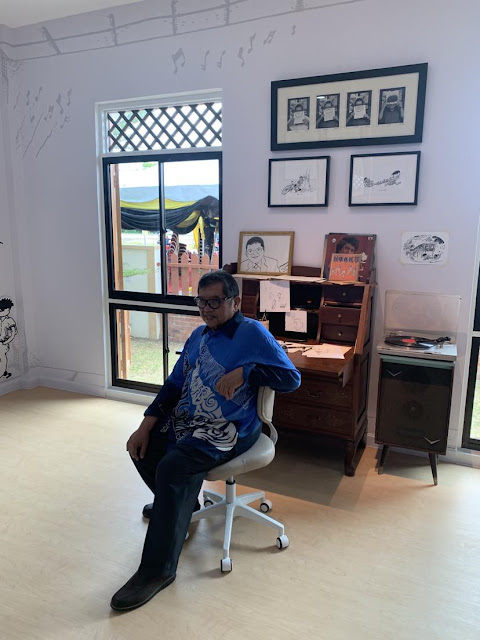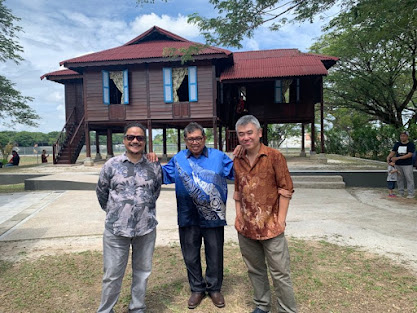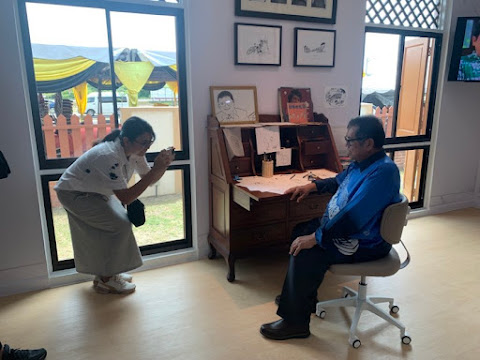by Lim Cheng Tju
(this article originally appeared in print as JUST A SIMPLE MAN. The Lat interview by Lim Cheng Tju in a Singaporean magazine, BigO (Jan 1994), pps. 59-60. It is reprinted and available outside Singapore for the first time here)
Mohd Nor Khalid is a traditional kind of fellow.
Better known as Lat, the Malaysian cartoonist is familiar to us in this region.
But his works have also gained quite a following in the United States. But
despite the fame and the high regard others have for his works, Lat retains a
simple lifestyle. He also carries the past with him and he will share it with
you easily over a cold beer or just laying back in a storeroom at the basement
of Nee Ann City where this interview was conducted. And there’s much laughter
during the interview. Perhaps it’s the man’s way of overcoming a certain
shyness among strangers. And the stories a way to reach out to another human
being.
LIM CHENG TJU: Do you consider
yourself as a political cartoonist?
LAT: No. I don’t do
political stuff. It’s social commentary. So, once a while I draw probably prime
ministers, minsters, prominent people because these people everybody knows.
People talks about. But not politics.
CT: So you don’t think your comics
will change people?
LAT: No. You can’t change
anything with drawings… never. I don’t know about the future or whether
somebody has done it. That’s not the reason for drawing. It’s to get in touch
with people, you know, to communicate. But if you read the Chinese papers in
Malaysia, you get a lot of political ones but quite mild, I think.
CT: Do you think there is room for
political cartooning in Malaysia?
LAT: Yeah. But it’s too late
for me anyway because I‘m known to people that I deal with certain things. Like
simple everyday life, scenery of Malaysian life, street scenes, living room
scenes.
CT: You having been freelancing
since you left The New Straits in 1984. Was it a difficult decision to make
then?
LAT: I was one of the first
to go out on my own and yeah, there were actually some days I was worried
because at that time I have a child. My first child, so no more of these
benefits, you know. But it’s fun. When I left The New Straits Times to be on my
own, it was because I have been going around and meeting cartoonists all over
the world and they are all freelancing. Many work at home and I learnt that’s
better. There’s freedom. But at the same time there are more responsibilities.
You are on your own.
CT: Is there a community of
cartoonists in Malaysia?
LAT: Yeah, we have an
association. I’m the president. It’s the second year. Many of the younger
cartoonists are still in their 20s. They draw for Gila Gila (a Malaysian version
of Mad magazine) and other magazines. They are good but we’ve got to give them
time because sometimes you don’t know how long a person wants to stay as a
cartoonist. They might just want to move on. Yeah, I do want to help them get
published. I hope they will come up to me and offer me their work. But
sometimes with cartoonists it is quite difficult. I know my character. I look
at myself and I know all are the same. All cartoonists are almost the same.
Very difficult to deal with. Sometimes you go an approach them, you get
nothing. Sometimes if you wait for them to hand over something to you, to offer
something, you also get nothing. So I don’t know… we just wait or what.
CT: Will there be a sequel to Mat
Som?
LAT: I don’t know… I did
that book because I want parents to know about how their children work and live
in the cities. It’s the same over the world. If I look around, it’s being done
in other countries. The same thing. The same story. They think their children
are doing very well. In my time when I first came to Kulua Lumpur, there was
very little pay and I had to struggle. And every time I went back to Ipoh or to
the kampung they were treating me, you know, as if I was making it in the city.
They would ask about life in Kuala Lumpur and they thought it was a glamorous
life. But actually there are so many things you have to go through but it’s
better to go through all these hardships than just to be spoon-fed. You know,
you get everything you want by 23, like what has happened to some people. By
26, they’ve got everything waiting. Finished college and then they’ve got a job
waiting. They’ve got a car waiting. You don’t really know what is real hardship
and work.
I have done some 40 to 50 pages for the second book.
But I don’t know when to finish it. So like I told you, there’s always
something waiting for me to do at home. It’s nice you know but then you get
tired of it so you do other things. Now I’m collecting books on ancient boats.
Mostly from our part of the world. The sea route. I don’t know what I want to
do with them. But I can see that that will be the background of something I
will do later but I don’t what is it. So don’t ask me ... Maybe I want to do a
story about Southeast Asia in ancient times.
CT: I found the panelling [i.e. panel layout] in Mat
Sam to be very cinematic. Was that done on purpose?
LAT: Yeah, that was done on
purpose. I got influenced by the Japanese way. I’m so used to newspapers
drawings. One big panel, you know, so I want to do that. As for the small size
format of the book, maybe I like it to look like a novel. But it’s a bit weak,
the story. There’s nothing spectacular. So ordinary. For many it worked. But if
I’m another cartoonist, I want him to be something different so that you can
have this and that. Mat Som is still a kampoung boy in the first book. Now I
make the other Mat Som in part two different. Maybe you’ll see that he’s no
longer that shy kampung fella. He becomes at city rat. Shout at motorcyclists
and cars and he’s got to move because his home that he is renting is being
turned into a condo or something. So he’s moving to a squatter house. And he’s
still not getting better off. But I’ll just leave that for a while. I don’t
know. I haven’t done it because of this Kampung Boy animation project. But when
I complete it, I might want to make it magazine size this time. I will still
publish it myself but I don’t know when. I spend too much time on the animation
now.

CT: You have been talking about
the Kampung Boy cartoon in interviews since the late ‘70s.
LAT: Yeah, it’s a dream. So
when this happen, I look forward to a series of it. But as you know, animation
takes more than one person. It’s a team project. It’s meant for TV but it’s
aimed at the international so there is a lot of story considerations involved.
It will only be 26 minutes but it has taken me more than a year. I started on
it July last year.
CT: How much of it has been done?
LAT: I have just finished
the second storyboard and the production will start very soon. It may be
completed this year. The funding comes from Malaysia but the animation itself
will be done in Canada and Philippines. I am working with two Canadians rights
now. One is the director and the other does the storyboard. In fact this guy
who does the storyboard, he is quite a young man. He has looked at me too much.
So much so that his Kampung Boy looks exactly like me. You know, a fat little
kampung boy. So I say no. Make him a thin boy because this was when I was a
kid. Don’t look at me now!
CT: Going back to an earlier
autobiographical book, Town Boy, can you tell us about your childhood
friendship with Frankie? (a Chinese boy whose parents own a coffee shop)
LAT: Many people have asked
me that. But what can I say? Frankie. I cannot tell you whether there’s a
Frankie. I don’t think anybody in my class would be able to come up to me and
say we know who’s Frankie but is that his real name? But I tell you. When I
went to that house above the coffee shop, I think I was in Standard 6. So it
was a happy occasion at that time. There was also pop music. We became friends
because of music. We talked about the music. We talk about the Beatles, other
singers and when a new hit came out, the feeling that you get … the morning you
wake up and you hear the song, wah! you know and then you cycle and you go see
a friend and discuss and then we later learnt to play. We also formed our band.
We did "Yellow Submarine" with the special effects. So that’s all. You know youth
and excitement. I remember all that because it’s in my head. To get that kind
of excitement is so difficult if you look for it. So it’s appreciation. You
appreciate music. It’s good. It’s better to appreciate music. It’s better to
appreciate something and then you have someone in common to share with you. That’s
better. Even politicians cannot tell two boys you must be friends. They say
look at the other fella, why should I be his friend? But because of music,
because of art, you know, you become friends.
 |
| CT Lim, Lat, and Miel in 2009 at Lat's kampung. |
CT: I suppose most of your stories
are created out of a feeling of nostalgia, having to grow up in a kampung and
then to move to the city. You said once that the more you listened to Neil
Young, the more you wanted to go back to the kampung.
LAT: I think Neil Young has
got an album called Old Ways. He was singing some old songs also. So, it’s not
only me. Everybody has that nostalgia thing, you know. First when you are in
your 20s, you suddenly realize you are an adult. So, you miss school days.
That’s the first nostalgia trip. Then when you are in your 30s, you miss
bachelorhood. Then when you are in your 40s, all sorts of things, many things.
Like in my case, I miss the quiet life because, you know, the children (Lat has
four of them) make so much noise. So sometimes I really wish it could be nice
if it’s quiet. But then because we are so used to all the noise then when it’s
so quiet, the children are missing, then you say, ah, it’s good if you could
hear the noise. It’s that kind of thing.
Nostalgia is … you know. Some people have it more than
others. But there’s nothing much you can do about it. And you must not live in
the past, of course. You look back so that you know the changes. Like me, I
look at the children and I say we spend too much money now because in those
days there was not money needed. No money at all for children to play. Now if
you take them to the shopping complex and then you got to pay to play the
computer games and all these electrical things. So the children, what they know
is where to put the money in. Even the two-year-old. You need it to put it
there or else the thing won’t move.
We didn’t know that because we were playing very
different games. So that’s why I tell the children so that they know. Parents
need to talk to their children. Just to bring them together. That’s all. It’s a
very common thing. Also I tell the children and families to just hold on for a
while and not to go too fast because we’re going too fast with everything. So
that’s it. Hold on, you know. Just some years ago I remember, we didn’t have to
pay like this. So is it necessary?
You know, usually Malaysians are not … the normal
kampung way of life is always be modest. That’s what everything is about. Be
modest and that’s why I always get scared when I have to spend money for
children. Every time my children ask for money and I would say what? Because
it’s so unnecessary. Let’s have something very simple, lah. Not so expensive.
It must be cheap. Better for me. That’s why even my book (Kampung Boy Yesterday
and Today), which costs $12.90. Now friends already call me up and say how come
so much? I say, “I’ve got some people coming with ideas to do coffee-table
books. They want to sell for M$150. You pay M$12.90 and you’re already
complaining, eh?” But you know the cost of printing and the cost of paper?
Already gone up. So that’s what I do.
CT: How do your children look at
the world of Lat?
LAT: Well, first of all,
when I told them I was living on a house on silts, they didn’t believe it. How
can you live like that? No TV? No one believes that there’s no TV because you
wake up in the morning and you see the TV. So yeah, in a way I sympathize
because they don’t have the space. They live in a little compound so they don’t
have it. For them to run you have to take them to the park. So I try my best to
take them out of town to the rural areas and show them.
Note: (1994) Thanks to Johnny Lau for arranging the interview
with Lat. (2023) Thanks to Karen Goh for re-transcribing the interview from the 1994 publication.























